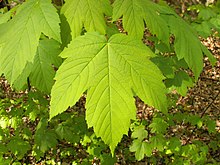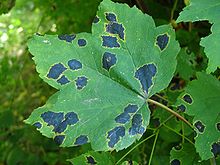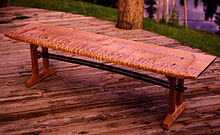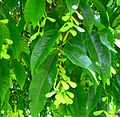Maple
| Maple Temporal range:
| |
|---|---|

| |
| Acer pseudoplatanus (sycamore maple) foliage | |
| Scientific classification | |
| Kingdom: | Plantae |
| Clade: | Tracheophytes |
| Clade: | Angiosperms |
| Clade: | Eudicots |
| Clade: | Rosids |
| Order: | Sapindales |
| Family: | Sapindaceae |
| Subfamily: | Hippocastanoideae |
| Genus: | Acer L. |
| Species | |
|
See either alphabetical list of species
| |

| |
| Distribution | |
Acer (
Evolutionary history
The closest relative of Acer is Dipteronia, which only has two living species in China, but has a fossil record extending back to the middle Paleocene in North America. The oldest known fossils of Acer are from the late Paleocene of Northeast Asia and northern North America, around 60 million years old. The oldest fossils of Acer in Europe are from Svalbard, dating to the late Eocene (Priabonian ~38–34 million years ago).[6]
Morphology

Most maples are trees growing to a height of 10–45 m (33–148 ft). Others are shrubs less than 10 meters tall with a number of small

Maples are distinguished by opposite
Maple species, such as
Maple flowers are green, yellow, orange or red. Though individually small, the effect of an entire tree in flower can be striking in several species. Some maples are an early spring source of pollen and nectar for bees.
The distinctive
The genus Acer together with genus Dipteronia are either classified in a family of their own, the Aceraceae, or else classified as members of the family Sapindaceae. Recent classifications, including the Angiosperm Phylogeny Group system, favour inclusion in Sapindaceae. When put in family Sapindaceae, genus Acer is put in subfamily Hippocastanoideae. The genus is subdivided by its morphology into a multitude of sections and subsections.[9][10] Molecular studies incorporating DNA sequence data from both chloroplast and nuclear genomes, aiming to resolve the internal relationships and reconstruct the evolutionairy history of the group, suggest a Late Paleocene origin for the group, appearing first in the northeastern Palearctic. Rapid lineage divergence was followed by several independent dispersals to the Nearctic and Western Palearctic regions.[11][12] Fifty-four species of maples meet the International Union for Conservation of Nature criteria for being under threat of extinction in their native habitat.[3]
Pests and diseases

The leaves are used as a food plant for the larvae of a number of the order Lepidoptera (see List of Lepidoptera that feed on maples). In high concentrations, caterpillars, like the greenstriped mapleworm (Dryocampa rubicunda), can feed on the leaves so much that they cause temporary defoliation of host maple trees.[13] Aphids are also very common sap-feeders on maples. In horticultural applications a dimethoate spray will solve this.
Infestations of the Asian long-horned beetle (Anoplophora glabripennis) have resulted in the destruction of thousands of maples and other tree species in Illinois, Massachusetts, New Jersey, New York, and Ohio in the United States and Ontario, Canada.[14][15]
Maples are affected by a number of
Cultural significance


A
It is also in the name of the Canadian ice hockey team, the Toronto Maple Leafs.
The first attested use of the word was in 1260 as "mapole", and it also appears a century later in
The maple leaf appears in the coat of arms of Sammatti, a former municipality of Uusimaa, Finland.[21][22]
Uses
Horticulture


Some species of maple are extensively planted as
Cultivars
Numerous maple cultivars that have been selected for particular characteristics can be propagated only by asexual reproduction such as cuttings, tissue culture, budding or grafting. Acer palmatum (Japanese maple) alone has over 1,000 cultivars, most selected in Japan, and many of them no longer propagated or not in cultivation in the Western world. Some delicate cultivars are usually grown in pots and rarely reach heights of more than 50–100 cm.

Bonsai

Maples are a popular choice for the art of
Collections

Maple collections, sometimes called aceretums, occupy space in many gardens and
Commercial uses
Maples are important as sources of syrup and wood. Dried wood is often used for the smoking of food. Charcoal from maples is an integral part of the Lincoln County Process used to make Tennessee whiskey.[24] They are also cultivated as ornamental plants and have benefits for tourism and agriculture.
Timber

Some of the larger maple species have valuable
Maple wood is often graded based on physical and aesthetic characteristics. The most common terminology includes the grading scale from common #2; which is unselected and often used for craft woods; common #1, used for commercial and residential buildings; clear; and select grade, which is sought for fine woodworking.[26]
Some maple wood has a highly decorative
These select decorative wood pieces also have subcategories that further filter the aesthetic looks. Crotch wood, bees wing, cats paw, old growth and mottled are some terms used to describe the look of these decorative woods.[27]
Maples have a long history of use for furniture production in the United States.[28] The Cherokee people would produce a purple dye from maple bark, which they used to dye cloth.[29][30]
Tonewood
Maple is considered a tonewood, or a wood that carries sound waves well, and is used in numerous musical instruments. Maple is harder and has a brighter sound than mahogany, which is another major tonewood used in instrument manufacturing.[31]
The back, sides, and neck of most violins, violas, cellos, and double basses are made from maple.
Maple is also often used to make bassoons and sometimes for other woodwind instruments like maple recorders.
Many drums are made from maple. From the 1970s to the 1990s, maple drum kits were a vast majority of all drum kits made, but in recent years, birch has become popular for drums once again. Some of the best drum-building companies use maple extensively throughout their mid-pro range.[4] Maple drums are favored for their bright resonant sound.[32] Certain types of drum sticks are also made from maple.
Agriculture
During late winter to early spring in northeastern
Also, as these trees are a major source of
Pulpwood
Maple is used as pulpwood. The fibers have relatively thick walls that prevent collapsing upon drying. This gives good bulk and opacity in paper. Maple also gives paper good printing properties.
Tourism
Many maples have bright
Gallery
-
Acer buergerianum var. formosanum leaves and fruit
-
Acer cappadocicum (Cappadocian maple)
-
Acer carpinifolium leaves
-
Acer ginnala foliage
-
Acer grandidentatum (bigtooth maple) in autumn colour
-
Acer griseum (paperbark maple)
-
Acer laevigatum leaves and fruit
-
Acer macrophyllum flowers and young leaves
-
Acer oliverianum The Chinese name "Qingfeng" comes from the bark color of the new branches and young trunk which are green.
-
Acer palmatum trees and bamboo in Japan
-
Acer palmatum leaf in autumn
-
Acer platanoides leaf
-
Acer platanoides (Norway maple) samaras
-
Acer rubrum leaves
-
Acer rubrum tree in autumn
-
Acer sempervirens foliage
See also
- List of Acer species
- List of Award of Garden Merit maples
- List of Danish Acers
- Mazer – a drinking vessel made from maple wood
- List of foods made from maple
References
Citations
- ^ Stevens, P. F. (2001 onwards). Angiosperm Phylogeny Website. Version 9, June 2008 [and more or less continuously updated since]. http://www.mobot.org/MOBOT/research/APweb/.
- ^ Xu, Tingzhi; Chen, Yousheng; de Jong, Piet C.; Oterdoom, Herman John; Chang, Chin-Sung. "Acer". Flora of China. Vol. 11. Retrieved 27 May 2012 – via eFloras.org, Missouri Botanical Garden, St. Louis, MO & Harvard University Herbaria, Cambridge, MA.
- ^ ISBN 978-1-905164-31-8
- ^ ISBN 978-0-585-25457-9
- ^ [1] Crowley (2020) Acer L. from the website Trees and Shrubs Online
- S2CID 231754169.
- ISBN 0-333-47494-5.
- ^ "Sky Hook Spirals from Plane" Popular Mechanics, December 1944, p. 75.
- ^ "Classification of Genus Acer". 12 August 2007. Archived from the original on 12 August 2007. Retrieved 19 November 2017.
- PMID 32742784.
- PMID 18853365.
- PMID 33508445.
- ^ "Auburn University Entomology and Plant Pathology | Greenstriped Mapleworm". Auburn University Entomology and Plant Pathology. Retrieved 2017-11-14.
- ^ "Fact Sheets". Umassgreeninfo.org. Retrieved 19 November 2017.
- ^ September 18, 2003 Asian Longhorned Beetle discovered in York Region Archived January 14, 2006, at the Wayback Machine
- ISBN 0-333-49493-8.
- ^ Fraser, Alistair B. (1998). "National Symbols". The Flag of Canada. Retrieved 19 November 2017.
- ^ Heritage, Canadian. "Official symbols of Canada - Canada.ca". Canada.pch.gc.ca. Retrieved 19 November 2017.
- ISBN 9781134687633.
- ^ "maple, n.1". Oxford University Press. Retrieved 19 November 2017 – via Oxford English Dictionary.
- ISBN 951-773-085-3.
- ^ "Sisäasiainministeriön vahvistamat kaupunkien, kauppaloiden ja kuntien vaakunat 1949-1995 I:13 Sammatti" (in Finnish). Kansallisarkiston digitaaliarkisto. Retrieved September 9, 2021.
- ^ D'Cruz, Mark. "Ma-Ke Bonsai Care Guide for Acer buergerianum". Ma-Ke Bonsai. Archived from the original on 2011-07-14. Retrieved 2011-07-05.
- ^ Zandona, Eric. "Tennessee Whiskey Gets a Legal Definition". EZdrinking. Retrieved 2014-01-11.
- ^ Sam Holman Maple Baseball Bats Archived 2010-05-16 at the Wayback Machine
- ^ "Publications" (PDF). Ahec.org. Retrieved 19 November 2017.
- ^ Wood Terms and Examples Archived 2010-03-14 at the Wayback Machine
- ISBN 978-0-517-03735-5. Retrieved 8 September 2010.
- OCLC 647927893
- ISBN 978-0-8061-0923-7.
- ^ "Archived copy". Archived from the original on 2021-03-02. Retrieved 2012-11-14.
{{cite web}}: CS1 maint: archived copy as title (link) - ISBN 978-0-87930-476-8. Retrieved 19 October 2010.
- ^ a b c d "Step-by-Step in the Production of Maple Syrup". Québec Maple Syrup Producers. 2021. Retrieved 4 October 2021.
- ^ Marowits, Ross (20 February 2017). "Quebec increases maple syrup production amid internal revolt, foreign competition". CBC. Archived from the original on 18 May 2017. Retrieved 21 May 2017.
- ^ "Trees for bees and other pollinators". Arbor Day Foundation. 2021. Retrieved 5 October 2021.
General bibliography
- Philips, Roger (1979). Trees of North America and Europe. New York: Random House, Inc. ISBN 0-394-50259-0.
- ISBN 9780585254579.

















